
You might have thought that last week was going to be the last of my Venetian posts. So did I!
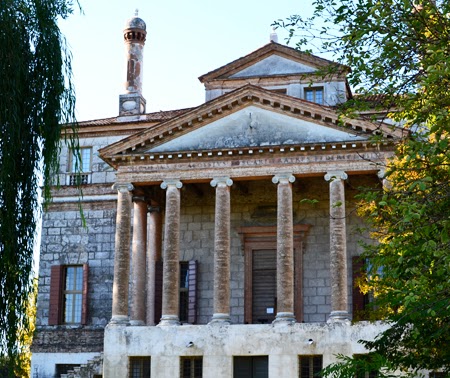 |
| Villa Foscari, “La Malcontenta” – front view |
Mark convinced me that there was one more to write. In fact, it isn’t about Venice but the Veneto – the mainland region that arcs around Venice’s western side.
In addition to his dreams of visiting Torcello, Mark has wanted (since he was at his mother’s knee) to visit some of Andrea Palladio’s villas. Mark rails against architects, builders and contractors (rightly so) for their abuse of his name and style in America, where it has become fashionable to call any ill-proportioned arched window slapped on a cheap new building “Palladian,” But from years of study, we know that this renaissance architect worked in sophisticated proportions and spatial harmony.
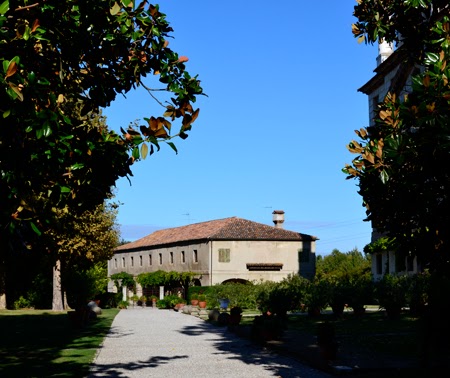 |
| Barchessa at Villa Foscari |
Palladio was born in Padua, and spent most of his career working in Vicenza. Several of his churches are in Venice, most prominently the churches of San Girogio Maggiore and Il Redentore. Most of Palladio’s works are in the Veneto, what our Venetian friends call “out on the mainland.”
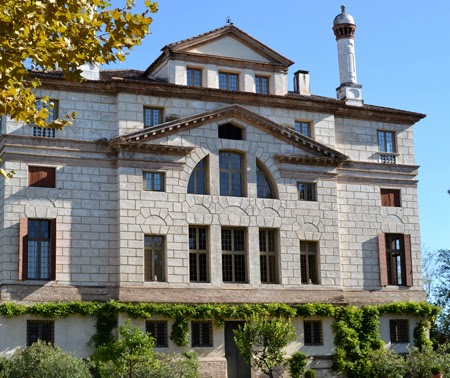 |
| Villa Foscari – back view |
But Palladio’s domestic architecture is what most fascinates Mark. Seeing them would require a car and a day in the Veneto.
How did Palladio arrange living spaces? What are the proportions? How were the barchesse (covered agricultural workspaces) integrated into the plans? What is the deal with all those frescoes?
So, we rented a car and took off for a very carefully planned day touring three of his villas: Villa Foscari, Villa Barbara, and Villa Emo.
We survived the stressful drive through the industrial port of Mestre, to arrive at Villa Foscari, also known as “La Malcontenta.” (At this point, I do have to tell you that Mark, knowing how challenging foreign driving can be, spent hours in advance of our trip on Google maps “Street View,” mapping each and every turn, noting all landmarks, where to park, and writing minutely specific directions to each villa. This made the day-trip so much easier!)
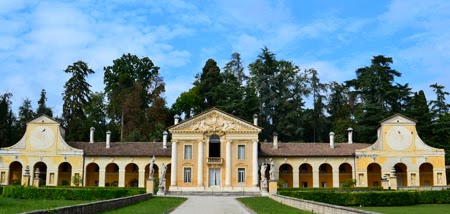 |
| Villa di Maser, “Villa Barbaro” – front view |
Situated on the Brenta River in the small village of Mira, Villa Foscari is first viewed from the road across the water. “Elegant” is the first word that came to my mind when I saw the main building in its beautiful setting. The second word was “stately.”
It amazed me that a home with incredibly large rooms and extremely high ceilings could feel so comfortable and inviting. I can’t say what it was about this particular villa, but by the end of the day we both agreed we could have moved in immediately. Perhaps its simplicity of plan captivated us, with two suites of three rooms each flanking a large central salon, or the tranquil views of fields and river stirred such dreams.
 |
| Villa di Maser, front gate with view of Tempieto Barbaro, a church also designed by Palladio |
Completed in 1560, Villa Foscari is richly decorated with frescoes by Battista Franco and Giambattista Zelotti. As opposed to the omnipresent religious art of Venice, these frescoes show mythological scenes, allegories of the Arts and Virtues, and scenes of villa life of ancient Rome. One room was decorated in the Grotesque Style; perhaps a cabinet or study, it was at this time of day the brightest and sunniest of all the rooms. Sadly, pollution and humidity have had a very negative effect on the frescoes and they are quite faded.
Unlike several of his country villas, at Villa Foscari the barchesse are not attached to the house; in the more traditional regional way, they are attached to adjacent farm buildings tucked behind a screen of trees. In some ways, it gave the main house a tall blocky feeling when viewed from the outside. Though a pleasure house, it was practical too; the uppermost story of the house was designed for grain storage. The grounds were lovely, too, with a willow fringed lawn on the riverbank in front, modest formal gardens to either side, and two plane tree-lined allées behind the house to assure a perfectly-framed view looking outward from the house.
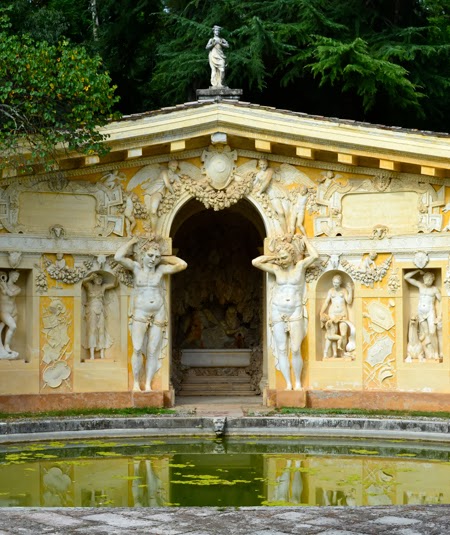 |
| Nympheum – giardino segreto di Villa di Maser |
We drove next to Palladio’s Villa di Maser, also known as Villa Barbaro. Based on a central living space similar to Villa Foscari, it differs in that its barchesse are attached on either side of the house and fronted by elegant loggias. This innovation gives the impression of an immense palace. Villa Barbaro is unusual (considering other Palladian villas with barchesse) in that family living quarters spread out partway into the upper floor of the barchesse. The lower story houses the usual support functions of stables, kitchens, wine presses, dovecotes or pigeoneries (the tower-like features at the ends), and agricultural work and storage areas.
The interior is frescoed by Paolo Veronese – probably his most extensive fresco cycle – dating to the 1560s (the villa was completed in the late 1550s). Once again, the walls and ceilings are adorned with beautiful mythical allegories, pastoral scenes, and detailed trompe-l’œil effects (such as faux doors, columns and niches, painted people and dogs peaking around corners) intended to make the rooms seem larger.
After our time in the villa, and strolling on its lawn and gardens, we stopped in De Gusto, a small gusteria tipica in one of the villa outbuildings across a side road. From their website, it seems they are the hopping night spot in the sleepy village, offering great food, and live music in the evenings. The tagline on their card reads: “It’s Kinda Funk.”
On this silent autumn afternoon, we spent an indolent hour or so in the low-sloping sun that streamed into the traditional rustic barchessa, nibbling at a board full of meats and cheeses, accompanied by a condiment that inspired today’s post: marmellata di Mela con Rafano or apple and horseradish jam.
The meats were familiar to us – prosciutto, salami, coppa, and porchetta – while I don’t think I could name a single one of the cheeses. There was a bowl of beautiful Castelvetrano olives, as well, and crusty bread warm from the oven. Knowing we had complex driving ahead of us, we reluctantly chose to forego the estate wine that would have been such a perfect accompaniment to this offering. The marmellata went so beautifully with the cheeses and meats that I knew I had to recreate it for you.
 |
| Villa Emo – front view |
Following our lunch, we headed off to our final stop for the day, Villa Emo. Completed in 1565, this villa was commissioned by Leonardo DI Alvise Emo in the town of Franzolo. My first impression was of the improbable ramp-like staircase to the entrance portico of the villa. It might have allowed for a carriage, except for the odd risers that interrupt the flow. What was Palladio thinking? This ramp was, in fact, designed to be ascended on foot or on horseback.
The barchesse of this estate are extremely long, visible indicators that this was an agricultural estate, and that the family was one of significant means. One practical aspect of these arch-lined barchesse is that they allow passage among all the domestic and practical spaces sheltered from summer sun and winter rain. The Emo family introduced maize – American corn – to the region, so we must be grateful to them, for without corn, there would be no tasty polenta for us!
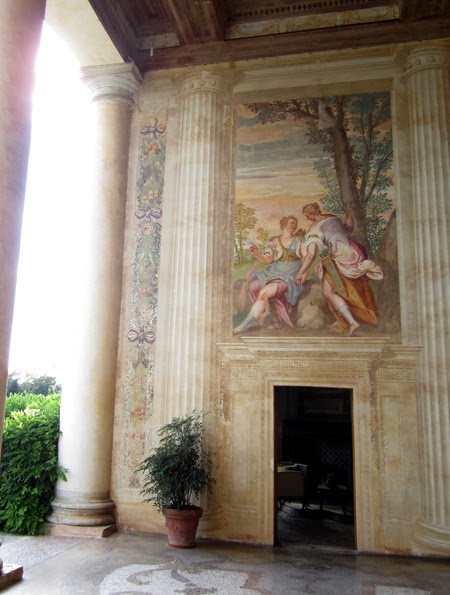 |
| A sense of scale and proportion; Villa Emo’s entry portico – photo: Mark Sammons |
The interior is sumptuously decorated with frescoes by Zelotti (remember him from Villa Foscari?) that again portray mythical allegories, as well as celebrations of the arts: poetry, music, architecture and astronomy. One fresco in a drawing room depicts corn, a source of pride for the family.
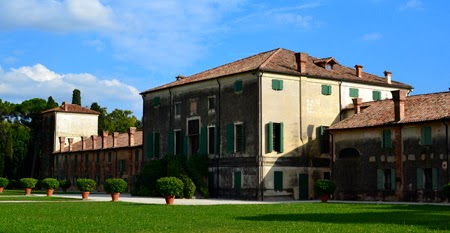 |
| Villa Emo – back view |
A couple of final notes from Mark: the basements of all these villas are fully above ground level because the water table is too high to recess basements into the ground. Also, the villas are not built of sumptuous stone and marble, but of humble brick and stucco, with some trim done in utilitarian terra cotta. For his wealthy and powerful patrons, Palladio eked grandeur and nobility from simple materials and reorganization of agrarian space.
After our long day, we drove back into Venice with little or no troubles, managed to fill up the gas tank, and return the car with no scratches or dings! As we walked back to our apartment, little did we know it was the last sunshine we would see for the next two weeks. But a taste of this marmellata instantly evokes that timeless sunny day…
~ David
Marmellata di Mela con Rafano
Apple Jam with Horseradish
1 pound apples (I used Pink Lady)
7 ounces (about 1 cup) granulated sugar
1/4 cup water
1 tablespoon prepared horseradish
Peel, core and slice apples. Place them in a heavy-bottomed saucepan and add the sugar and water. Bring to a boil over medium-high heat and cook for about 15-20 minutes – until apples are soft and sugar-water has turned syrupy. Add the horseradish and purée the mixture in a food processor or using a stick blender. Cook one minute more and then scoop into a jar to cool.
Serve as a condiment to cheeses and meats.
Makes approximately 1 1/2 cups.
This site uses Akismet to reduce spam. Learn how your comment data is processed.
Developed and maintained by Inspiratech LLC.
Design by Themeshift.
Magda
December 7, 2013 at 3:02 pmHi David. Such wonderful photographs, you guys really enjoyed your time in Italy it seems.
I'm going to focus on the food right now because such types of jams are my weakness. I love them! Horseradish is such a strange ingredient to add to a sweet jam but I know it's delicious. Thanks for sharing the recipe.
Cocoa & Lavender
December 7, 2013 at 3:10 pmWe did have a wonderful time, Magda, and I am so glad we had a sunny day for visiting these villas! The horseradish was a real surprise for us, but it is a perfect foil for strong cheeses. I think you will like it!
john | heneedsfood
December 7, 2013 at 9:23 pmWell it looks like Mark's meticulous planning paid off. Such gorgeous villas and so nice that you got to see them beneath vivid blue skies. Thanks for sharing!
I quite intrigued by this jam. I can already tell that it's more sweet and fruity, with a hint of horseradish bite. I think I may introduce this to the appetisers we're doing at our place on Christmas day.
Cocoa & Lavender
December 8, 2013 at 2:39 pmI wish I had interior shots of the villas (no photos allowed…) – you would want to move in, although that would require seeing the kitchen first, I am sure…
I think you will like the jam… quite different and I just found out yesterday that Mark prefers his with meats, while I like mine with the cheeses.
Ahu Shahrabani
December 8, 2013 at 2:43 amThis jam sounds incredible. I could imagine pairing it with manchego. Yum. And i love mark's road trip planning style!! Thank you for the additional post 🙂
Cocoa & Lavender
December 8, 2013 at 2:39 pmMy pleasure, Ahu! It is really great with manchego – we immediately thought of membrillo when we had it. And the horseradish is a nice touch!
Anonymous
December 8, 2013 at 11:38 amSimply stunning photography, this series of posts has made me want to visit Italy and I keep secretly hoping you will find one more thing to write about so we can enjoy some more Italian magic…like maybe Italian desserts 🙂 Mark sounds so like Mr LG, when we did a driving holiday through France he did detailed maps for every bit of driving we had to do. People laugh but really it makes life and travelling so much easier.
This jam sounds amazing, I have not had horseradish with apple jam before so I must give it a try.
Cocoa & Lavender
December 8, 2013 at 2:41 pmThanks, Karen – it is very convenient when we have our own personal navigators and guides… All I need to do is set up the beginning and the end, and where we stay, and Mark takes the rest. Nice combo…
Hope you like the jam if you try it!
laurasmess
December 8, 2013 at 3:04 pmAnother amazing post David!! Wow. Love the sound of the jam but the photos absolutely blew me away! As per your other posts, I am itching to get myself to Venice now. Gorgeous. In the meantime, I'll make this jam (the horseradish sounds intriguing).
Cocoa & Lavender
December 10, 2013 at 12:50 pmThanks, Laura – it has been fun taking you all with us on our trip… well, virtually anyway!
CQUEK
December 8, 2013 at 4:53 pmwhat a wonderful trip
Cocoa & Lavender
December 10, 2013 at 12:50 pmThanks!
Anonymous
December 8, 2013 at 5:22 pmI've always made a jar or two of apple sauce with horseradish when making a big batch of the usual variety – this sounds wonderful and the pictures were a feast for the eyes! LOVE IT! Karin
Cocoa & Lavender
December 10, 2013 at 12:51 pmKarin – it is funny because we had never heard of the apples and horseradish combo until this trip and, since back, several people have mentioned it.
Susan Manfull
December 8, 2013 at 11:42 pmGorgeous. Nothing else needs to be said. But, okay, I will add that the Marmellata sounds delicious. An inspiring post!! So glad you took Mark's advice to include one more article about Venice and its surroundings!
Cocoa & Lavender
December 10, 2013 at 12:52 pmThanks, Susan – I am so glad you like this post. It was definitely more history and architecture than food, but that is okay with us!
Unknown
December 9, 2013 at 3:57 amDavid, what lovely photos and I so wish I was driving around Venice looking at this beautiful architecture. It sounds like such a wonderful day enjoying beauty and art and food! This marmelleta sounds fascinating with the horseradish and all. Sounds perfect with cheese and warm bread. Have a great week David!
Cocoa & Lavender
December 10, 2013 at 12:53 pmNazneen – I hope you can get to Venice soon (before it sinks!)… I can really imagine you enjoying the food, people, art and architecture so much!
Colette (Coco)
December 9, 2013 at 7:25 pmApples & horseradish – what a delicious combo, D. Gotta try this.
Another beautiful post! xo
Cocoa & Lavender
December 10, 2013 at 12:54 pmThanks, Colette – we were surprised at how many people already knew about and made this combination. We had never heard of it!
Andrea_TheKitchenLioness
December 10, 2013 at 9:11 amDavid, now that I have finally had some peace and quiet and read through and enjoy your amazing post in all its details – I feel like I learned a ton and ejoyed it so much! The photgraphy is amazing, the history is incredible and your descriptions make us all who read this want to go and pack our bags and take off for a visit to all these amazing places! Thank you for yet another btreathtaking post about your travels to and around Venice and a thank you also to Mark for his insisitance!
Now onto the recipe – a very lovely yet unusal combination – I think I would enjoy your Aple Jam with very thinly sliced pork tenderloin.
Ganz liebe Grüße und Danke für den tollen Post,
Andrea
Cocoa & Lavender
December 10, 2013 at 12:55 pmPeace and quiet during this season? Wow – that is amazing!! Das is unglaublich! Yes, this would be perfect with a pork tenderloin!
Anonymous
December 10, 2013 at 11:39 amhorseradish must be adding such a unique and pleasing aroma to the jam…this dish is quite new to us we got hooked by looking at its sunny color…a must try soon and perfect for warming up a winter breakfast time…..and all those clicks are stunning…you are seriously a great photographer,thanks for the inspiration 🙂
Cocoa & Lavender
December 10, 2013 at 12:49 pmThank you, Rakesh and Swikruti – you are so very kind! It is really fun to find unusual flavor combinations like this one.
Valentina
December 24, 2013 at 9:33 amI love all things sweet & spicy — I've never had this combination, but it sounds divine.
Cocoa & Lavender
December 24, 2013 at 5:54 pmAs you can tell, Valentina, the most fun I had there was finding new food combinations… tuna & cocoa? apple & horseradish? It's all good!